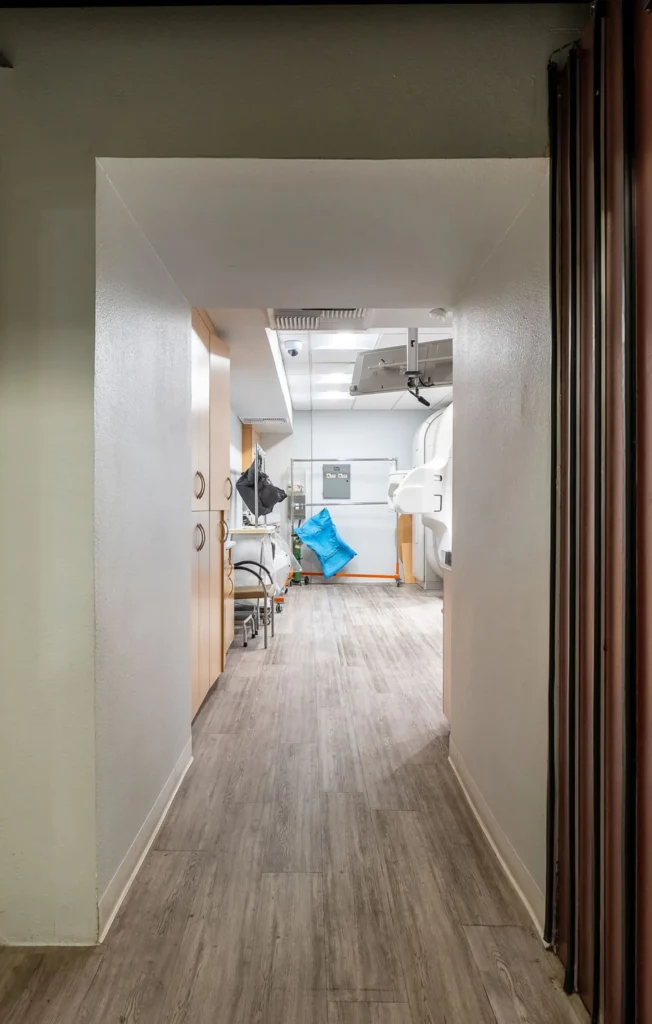Image-Guided Radiation Therapy (IGRT)
Utilizes advanced imaging (e.g., CT, MRI, PET) before and during treatment to ensure radiation targets the exact tumor location, reducing margins and improving accuracy.
What is IGRT?
Image-Guided Radiation Therapy (IGRT) is an advanced form of radiation therapy that uses real-time imaging to enhance accuracy during each treatment session. By capturing detailed images—such as CT, MRI, or PET scans—just before and even during radiation delivery, IGRT allows your care team to pinpoint the exact location of your tumor. This reduces the need for large treatment margins and ensures that healthy tissue is spared as much as possible.
How It Works
Pre-Treatment Imaging
Before each session, advanced imaging technology captures high-resolution images of your tumor and surrounding anatomy. These are compared to your original planning scans to detect even the smallest changes in tumor size or position.
Precise Adjustments
If any movement is detected—due to natural body shifts, breathing, or changes in anatomy—your care team can adjust your position or the radiation beams in real time to maintain precision.
Daily Targeting Accuracy
Because tumors can shift from day to day, IGRT ensures that radiation is delivered to the correct spot every time, even if your internal anatomy has changed slightly.
Benefits of IGRT
Enhanced Accuracy
Imaging before each treatment allows for more accurate targeting of tumors, especially those located near sensitive structures.
Smaller Margins, Less Risk
By reducing the buffer area around tumors, less healthy tissue is exposed to radiation.
Improved Outcomes
Higher precision can lead to more effective treatment with fewer side effects.
Adaptive Radiotherapy Support
IGRT serves as a foundation for adaptive treatment planning, allowing adjustments as your body responds to therapy.

Common Uses for IGRT
Are near critical structures or organs
Tend to shift in position due to breathing or digestion
Require tight margins for safe and effective treatment
Common examples include:
Lung and thoracic cancers
Prostate cancer
Head and neck cancers
Abdominal and pelvic tumors
Spinal or brain tumors
What to Expect During Treatment
Daily Imaging
Before each session, you’ll undergo a quick imaging scan (usually in the treatment room itself).
Positioning Aids
Custom molds, cushions, or masks may be used to help keep you still and aligned.
Quick Adjustments
If needed, the team will reposition you to ensure the radiation beams are targeting the exact tumor location.
Comfortable Sessions
IGRT adds only a few extra minutes to your daily treatment but can significantly enhance precision.
Learn More About Radiant Cancer Center
With our office based out of Rancho Mirage, our treatment center is conveniently located to serve the entire Coachella Valley.
Every step of your care is monitored and adjusted to ensure the highest accuracy.
Other Services We Offer
Interested in exploring other precision-focused radiation therapies?
Intensity‑Modulated Radiation Therapy (IMRT)
Advanced radiation treatment designed to target tumors with precision while protecting healthy tissue.
Surface-Guided Radiation Therapy (SGRT)
Uses 3D camera systems to monitor patient surface motion in real-time. SGRT enhances accuracy and safety by automatically pausing treatment if movement exceeds designated thresholds.
Stereotactic Radiosurgery (SRS)
A non‑surgical, highly focused form of radiation therapy that targets tumors in the brain, spine, or other areas with pinpoint accuracy. Using multiple beams that converge on the tumor, SRS delivers high-dose radiation in a single session, sparing surrounding healthy tissue.
